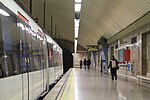Raimundo Saporta Pavilion
1966 establishments in Spain2004 disestablishments in SpainBasketball venues in SpainDefunct basketball venuesDefunct indoor arenas ... and 7 more
Defunct sports venues in SpainDemolished buildings and structures in SpainFormer buildings and structures in MadridFormer sports venues in MadridReal Madrid BaloncestoSports venues completed in 1966Sports venues demolished in 2004
Raimundo Saporta Pavilion (originally known as Pabellón de la Ciudad Deportiva del Real Madrid) was an indoor arena located in Madrid, Spain. It was used particularly for basketball matches of Real Madrid. Until 1999, it was known as the Pabellón de la Ciudad Deportiva del Real Madrid, when it was renamed in honor of the former president of Real Madrid's basketball team, the late Raimundo Saporta.The arena was demolished in 2004.
Excerpt from the Wikipedia article Raimundo Saporta Pavilion (License: CC BY-SA 3.0, Authors).Raimundo Saporta Pavilion
Anillo Distribuidor Cuatro Torres, Madrid
Geographical coordinates (GPS) Address Nearby Places Show on map
Geographical coordinates (GPS)
| Latitude | Longitude |
|---|---|
| N 40.479218 ° | E -3.687662 ° |
Address
Anillo Distribuidor Cuatro Torres
28046 Madrid (Fuencarral-El Pardo)
Community of Madrid, Spain
Open on Google Maps










